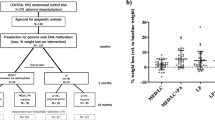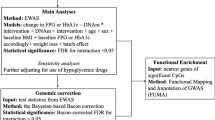Abstract
Purpose
The interindividual variable response to weight-loss treatments requires the search for new predictive biomarkers for improving the success of weight-loss programs. The aim of this study is to identify novel genes that distinguish individual responses to a weight-loss dietary treatment by using the integrative analysis of mRNA expression and DNA methylation arrays.
Methods
Subjects from Metabolic Syndrome Reduction in Navarra (RESMENA) project were classified as low (LR) or high (HR) responders depending on their weight loss. Transcriptomic (n = 24) and epigenomic (n = 47) patterns were determined by array-based genome-wide technologies in human white blood cells at the baseline of the treatment period. CD44 expression was validated by qRT-PCR and methylation degree of CpGs of the gene was validated by MassARRAY® EpiTYPER™ in a subsample of 47 subjects. CD44 protein levels were measured by ELISA in human plasma.
Results
Different expression and DNA methylation profiles were identified in LR in comparison to HR. The integrative analysis of both array data identified four genes: CD44, ITPR1, MTSS1 and FBXW5 that were differently methylated and expressed between groups. CD44 showed higher expression and lower DNA methylation levels in LR than in HR. Although differences in CD44 protein levels between LR and HR were not statistically significant, a positive association was observed between CD44 mRNA expression and protein levels.
Conclusions
In summary, the combination of a genome-wide methylation and expression array dataset can be a useful strategy to identify novel genes that might be considered as predictors of the dietary response. CD44 gene transcription and methylation may be a possible candidate biomarker for weight-loss prediction.




Similar content being viewed by others
References
Kaur J, Jaspinder (2014) A comprehensive review on metabolic syndrome. Cardiol Res Pract 2014:943162. https://doi.org/10.1155/2014/943162
Goni L, Cuervo M, Milagro FI, Martínez JA (2015) A genetic risk tool for obesity predisposition assessment and personalized nutrition implementation based on macronutrient intake. Genes Nutr 10:445. https://doi.org/10.1007/s12263-014-0445-z
de la Iglesia R, Lopez-Legarrea P, Abete I et al (2014) A new dietary strategy for long-term treatment of the metabolic syndrome is compared with the American Heart Association (AHA) guidelines: the MEtabolic Syndrome REduction in NAvarra (RESMENA) project. Br J Nutr 111:643–652. https://doi.org/10.1017/S0007114513002778
Guo S, Yan F, Xu J et al (2015) Identification and validation of the methylation biomarkers of non-small cell lung cancer (NSCLC). Clin Epigenetics 7:3. https://doi.org/10.1186/s13148-014-0035-3
de Toro-Martín J, Arsenault B, Després J-P, Vohl M-C (2017) Precision nutrition: a review of personalized nutritional approaches for the prevention and management of metabolic syndrome. Nutrients 9:913. https://doi.org/10.3390/nu9080913
Tremblay BL, Cormier H, Rudkowska I et al (2015) Association between polymorphisms in phospholipase A2 genes and the plasma triglyceride response to an n-3 PUFA supplementation: a clinical trial. Lipids Health Dis 14:12. https://doi.org/10.1186/s12944-015-0009-2
Rudkowska I, Perusse L, Bellis C et al (2015) Interaction between common genetic variants and total fat intake on low-density lipoprotein peak particle diameter: a genome-wide association study. J Nutrigenet Nutrigenomics 8:44–53. https://doi.org/10.1159/000431151
Vallée Marcotte B, Cormier H, Guénard F et al (2016) Novel genetic loci associated with the plasma triglyceride response to an omega-3 fatty acid supplementation. J Nutrigenet Nutrigenomics 9:1–11. https://doi.org/10.1159/000446024
González-Muniesa P, Mártinez-González M-A, Hu FB et al (2017) Obesity. Nat Rev Dis Primers 3:17034. https://doi.org/10.1038/nrdp.2017.34
Heianza Y, Qi L (2017) Gene–diet interaction and precision nutrition in obesity. Int J Mol Sci 18:78. https://doi.org/10.3390/ijms18040787
Cordero P, Campion J, Milagro FI, Martinez JA (2013) Transcriptomic and epigenetic changes in early liver steatosis associated to obesity: effect of dietary methyl donor supplementation. Mol Genet Metab 110:388–395. https://doi.org/10.1016/j.ymgme.2013.08.022
Martínez JA, Etxeberría U, Galar A, Milagro FI (2013) Role of dietary polyphenols and inflammatory processes on disease progression mediated by the gut microbiota. Rejuvenation Res 16:435–437. https://doi.org/10.1089/rej.2013.1481
Choi S-W, Claycombe KJ, Martinez JA et al (2013) Nutritional epigenomics: a portal to disease prevention. Adv Nutr 4:530–532. https://doi.org/10.3945/an.113.004168
Remely M, Lovrecic L, De La Garza AL et al (2015) Therapeutic perspectives of epigenetically active nutrients. Br J Pharmacol 172:2756–2768
Karimi M, Vedin I, Freund Levi Y et al (2017) DHA-rich n-3 fatty acid supplementation decreases DNA methylation in blood leukocytes: the OmegAD study. Am J Clin Nutr 106:1157–1165. https://doi.org/10.3945/ajcn.117.155648
Perfilyev A, Dahlman I, Gillberg L et al (2017) Impact of polyunsaturated and saturated fat overfeeding on the DNA-methylation pattern in human adipose tissue: a randomized controlled trial. Am J Clin Nutr 105:991–1000. https://doi.org/10.3945/ajcn.116.143164
Armenise C, Lefebvre G, Carayol J et al (2017) Transcriptome profiling from adipose tissue during a low-calorie diet reveals predictors of weight and glycemic outcomes in obese, nondiabetic subjects. Am J Clin Nutr 106:736–746. https://doi.org/10.3945/ajcn.117.156216
Goni L, Milagro FI, Cuervo M, Martínez JA (2014) Single-nucleotide polymorphisms and DNA methylation markers associated with central obesity and regulation of body weight. Nutr Rev 72:673–690. https://doi.org/10.1111/nure.12143
Zulet MA, Bondia-Pons I, Abete I et al (2011) The reduction of the metabolic syndrome in Navarra-Spain (RESMENA-S) study; a multidisciplinary strategy based on chrononutrition and nutritional education, together with dietetic and psychological control. Nutr Hosp 26:16–26. https://doi.org/10.3305/nh.2011.26.1.5050
Moher D, Hopewell S, Schulz KF et al (2012) CONSORT 2010 explanation and elaboration: updated guidelines for reporting parallel group randomised trials. Int J Surg 10:28–55. https://doi.org/10.1016/j.ijsu.2011.10.001
Friedewald WT, Levy RI, Fredrickson DS (1972) Estimation of the concentration of low-density lipoprotein cholesterol in plasma, without use of the preparative ultracentrifuge. Clin Chem 18:499–502
Touleimat N, Tost J (2012) Complete pipeline for Infinium® Human Methylation 450K BeadChip data processing using subset quantile normalization for accurate DNA methylation estimation. Epigenomics 4:325–341. https://doi.org/10.2217/epi.12.21
Mansego ML, Milagro FI, Campión J, Martínez JA (2013) Techniques of DNA methylation analysis with nutritional applications. J Nutrigenet Nutrigenomics 6:83–96. https://doi.org/10.1159/000350749
Rao X, Huang X, Zhou Z, Lin X (2013) An improvement of the 2(−ΔΔCT) method for quantitative real-time polymerase chain reaction data analysis. Biostat Bioinform Biomath 3:71–85
Milagro FI, Campion J, Cordero P et al (2011) A dual epigenomic approach for the search of obesity biomarkers: DNA methylation in relation to diet-induced weight loss. FASEB J 25:1378–1389. https://doi.org/10.1096/fj.10-170365
Diboun I, Wernisch L, Orengo CA, Koltzenburg M (2006) Microarray analysis after RNA amplification can detect pronounced differences in gene expression using limma. BMC Genom 7:252. https://doi.org/10.1186/1471-2164-7-252
Smyth GK (2005) limma: linear models for microarray data. In: Bioinformatics and computational biology solutions using R and bioconductor. Springer, New York, pp 397–420
Guh DP, Zhang W, Bansback N et al (2009) The incidence of co-morbidities related to obesity and overweight: a systematic review and meta-analysis. BMC Public Health 9:88. https://doi.org/10.1186/1471-2458-9-88
Rendo-Urteaga T, García-Calzón S, González-Muniesa P et al (2015) Peripheral blood mononuclear cell gene expression profile in obese boys who followed a moderate energy-restricted diet: differences between high and low responders at baseline and after the intervention. Br J Nutr 113:331–342. https://doi.org/10.1017/S0007114514003584
Bouchard L, Rabasa-Lhoret R, Faraj M et al (2010) Differential epigenomic and transcriptomic responses in subcutaneous adipose tissue between low and high responders to caloric restriction. Am J Clin Nutr 91:309–320. https://doi.org/10.3945/ajcn.2009.28085
Bacos K, Gillberg L, Volkov P et al (2016) Blood-based biomarkers of age-associated epigenetic changes in human islets associate with insulin secretion and diabetes. Nat Commun 7:11089. https://doi.org/10.1038/ncomms11089
Chaplin A, Palou A, Serra F (2017) Methylation analysis in fatty-acid-related genes reveals their plasticity associated with conjugated linoleic acid and calcium supplementation in adult mice. Eur J Nutr 56:879–891. https://doi.org/10.1007/s00394-015-1135-3
Moleres A, Campion J, Milagro FI et al (2013) Differential DNA methylation patterns between high and low responders to a weight loss intervention in overweight or obese adolescents: the EVASYON study. FASEB J 27:2504–2512. https://doi.org/10.1096/fj.12-215566
Zhang G, Pradhan S (2014) Mammalian epigenetic mechanisms. IUBMB Life 66:240–256
Zhuang J, Peng W, Li H et al (2012) Methylation of p15INK4b and expression of ANRIL on chromosome 9p21 are associated with coronary artery disease. PLoS One 7:e47193. https://doi.org/10.1371/journal.pone.0047193
Wadhwa PD, Buss C, Entringer S, Swanson JM (2009) Developmental origins of health and disease: brief history of the approach and current focus on epigenetic mechanisms. Semin Reprod Med 27:358–368
Vogel C, Marcotte EM (2012) Insights into the regulation of protein abundance from proteomic and transcriptomic analyses. Nat Rev Genet 13:227–232. https://doi.org/10.1038/nrg3185
Kodama K, Horikoshi M, Toda K et al (2012) Expression-based genome-wide association study links the receptor CD44 in adipose tissue with type 2 diabetes. Proc Natl Acad Sci USA 109:7049–7054. https://doi.org/10.1073/pnas.1114513109
Liu LF, Kodama K, Wei K et al (2015) The receptor CD44 is associated with systemic insulin resistance and proinflammatory macrophages in human adipose tissue. Diabetologia 58:1579–1586. https://doi.org/10.1007/s00125-015-3603-y
Bertola A, Deveaux V, Bonnafous S et al (2009) Elevated expression of osteopontin may be related to adipose tissue macrophage accumulation and liver steatosis in morbid obesity. Diabetes 58:125–133. https://doi.org/10.2337/db08-0400
Crujeiras AB, Diaz-Lagares A, Sandoval J et al (2017) DNA methylation map in circulating leukocytes mirrors subcutaneous adipose tissue methylation pattern: a genome-wide analysis from non-obese and obese patients. Sci Rep 7:41903. https://doi.org/10.1038/srep41903
Acknowledgements
We thank the participants of the RESMENA project and technical assistance of Enrique Buso (UCIM, University of Valencia) for the MassARRAY measurements. The technical assistance of Veronica Ciaurriz and Ana Lorente is gratefully acknowledged. We credit the financial support of Ministry of Economy, Industry and Competitiveness (Nutrigenio Project reference AGL2013-45554-R) and Spanish Biomedical Research Centre CIBER de Fisiopatología de la Obesidad y Nutrición (CIBERobn). Mirian Samblas holds a FPI Grant from the Ministry of Education, Culture and Sport (BES-2014-068409).
Author information
Authors and Affiliations
Corresponding author
Ethics declarations
Conflict of interest
The authors have nothing to declare.
Electronic supplementary material
Below is the link to the electronic supplementary material.
Rights and permissions
About this article
Cite this article
Samblas, M., Mansego, M.L., Zulet, M.A. et al. An integrated transcriptomic and epigenomic analysis identifies CD44 gene as a potential biomarker for weight loss within an energy-restricted program. Eur J Nutr 58, 1971–1980 (2019). https://doi.org/10.1007/s00394-018-1750-x
Received:
Accepted:
Published:
Issue Date:
DOI: https://doi.org/10.1007/s00394-018-1750-x




